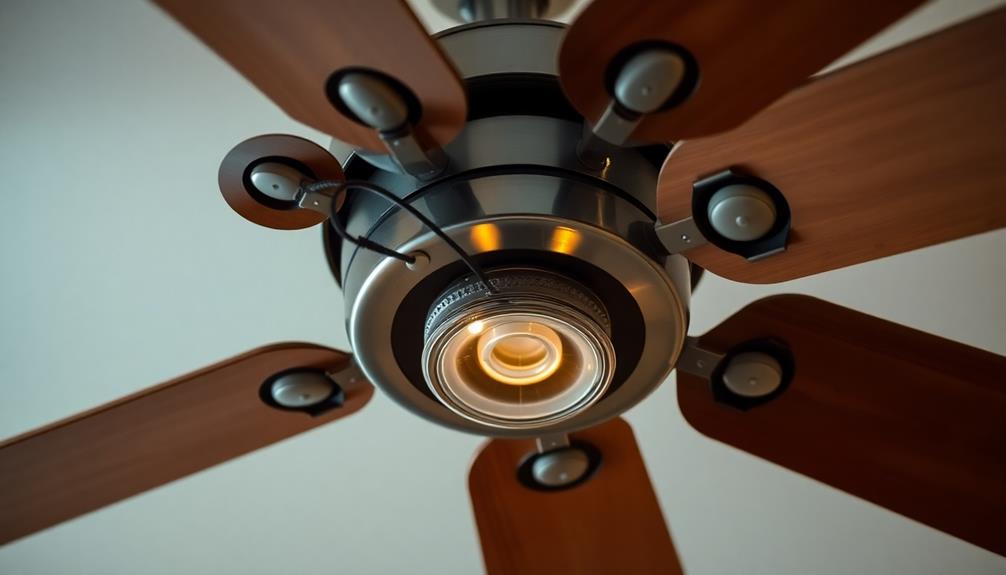Humming fans can be quite irritating, but the root cause can usually be identified. It may be due to unbalanced blades, loose screws, or worn-out motor components. Even electrical problems such as frayed wires can cause that annoying buzz. Routine maintenance tasks like tightening screws and cleaning blades can significantly reduce the noise level. Be sure to inspect for any misalignments or damaged wiring, as these are common culprits for humming noises. Keep in mind that pinpointing the exact issue can help bring back a peaceful environment. There are plenty more tips to discover to ensure that your fan runs smoothly and quietly.
Key Takeaways
- Humming fans often result from unbalanced blades, loose screws, or electrical issues that create vibrations and noise.
- Regular inspection and maintenance, including tightening screws and cleaning blades, can significantly reduce humming sounds.
- Loose or damaged wiring can cause buzzing noises; check and secure connections to eliminate unwanted sounds.
- Worn-out motor bearings or misalignment can lead to increased noise; lubricate bearings and ensure proper alignment for quieter operation.
- Environmental factors like dust buildup and nearby electronics can influence fan noise; regular cleaning and minimizing interference can help.
Causes of Humming Noise
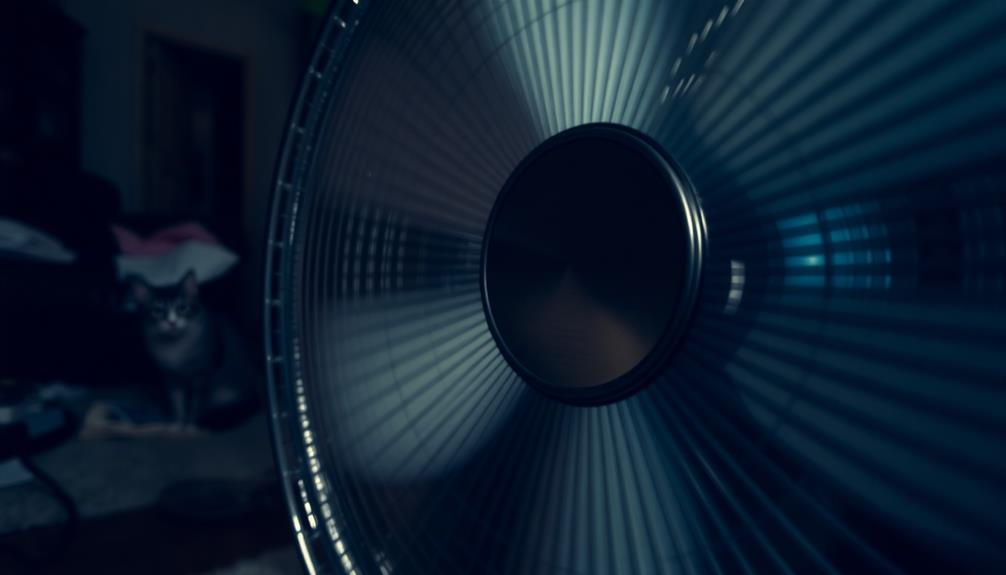
When your ceiling fan starts humming, it can be frustrating, especially if you rely on it for comfort. This humming often stems from several causes.
Unbalanced blades may lead to uneven weight distribution, resulting in vibrations and noise. Additionally, electrical issues like loose or frayed wires can create buzzing sounds; inspecting these connections is essential.
Sometimes, worn-out motor bearings or misaligned components can lead to excessive humming, indicating motor problems.
Finally, excessive vibration from the mounting bracket might contribute to the noise.
Regular inspection and maintenance can help you identify these issues early, ensuring your fan operates smoothly and quietly, enhancing your overall comfort.
Don't ignore those sounds; they often signal the need for attention.
Loose Screws and Their Impact
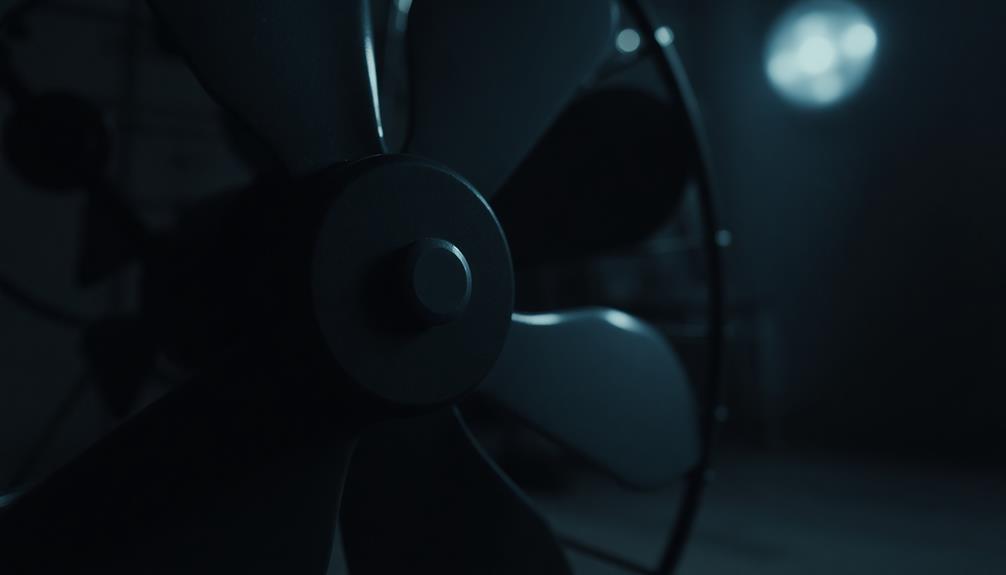
Loose screws can considerably impact the performance of your ceiling fan, leading to unwanted humming noises. When screws aren't tightened properly, they create vibrations that amplify sound. It's vital to regularly check and tighten the screws on the fan blades to guarantee smooth operation.
| Screw Status | Impact on Fan |
|---|---|
| Tightened | Quiet and efficient |
| Slightly Loose | Mild humming |
| Moderately Loose | Noticeable vibrations |
| Very Loose | Loud humming and wobbling |
Unbalanced Blades Explained
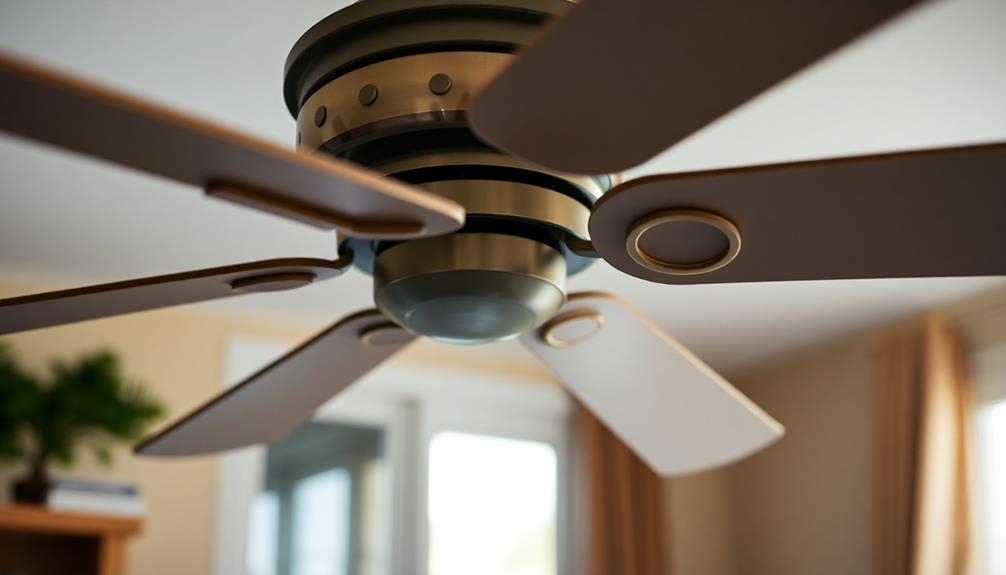
Unbalanced blades can considerably disrupt the performance of your ceiling fan, leading to unwanted humming and wobbling.
This imbalance often stems from uneven weight distribution caused by loose blade screws, bent, or improperly pitched blades. You'll notice that a simple misalignment can exacerbate the issue, making the fan work harder and produce more noise.
Regularly inspecting the blades and tightening any loose screws is essential for maintaining balance. If you find warped blades, consider replacing them to restore smooth operation.
Remember, keeping the blades clean and free from dust also helps improve overall efficiency.
Electrical Issues and Solutions
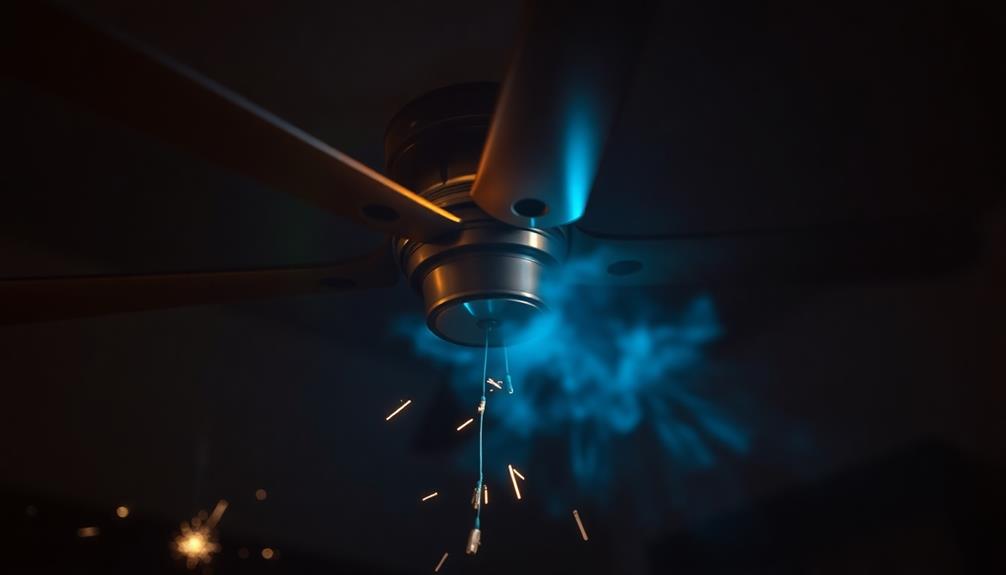
Have you ever noticed your ceiling fan humming even when it's running smoothly? This annoying noise might stem from electrical issues.
Start by inspecting the wiring connections; loose or frayed wires can create unwanted sounds. If you find any damaged wires, secure or replace them as needed. Additionally, confirming that your fan is energy efficient can help reduce operational noise; modern Energy Star certified fans are designed to operate quietly.
Next, check the capacitors for leakage or discoloration, as faulty capacitors can contribute to humming. Ascertain the voltage supplied to the fan matches the manufacturer's specifications, too.
Don't forget about the switches; a faulty switch may need replacing to eliminate noise. By addressing these electrical concerns, you can enjoy a quieter fan and a more pleasant environment in your home. Regular checks can help you catch these issues early.
Motor Problems to Consider

Motor problems often lead to excessive humming noise in ceiling fans. If you notice this issue, there are a few key factors to evaluate:
- Worn-Out Bearings: Friction from worn bearings can create humming noises.
- Misalignment: Misaligned motor components can cause vibrations and increased noise.
- Loose Mounts: If motor mounts are loose, it may result in buzzing sounds due to instability.
- Damaged Windings: Faulty motor windings can lead to electrical imbalances and humming.
- Overheating: An overheating motor can produce excessive noise and should be addressed immediately.
Vibration From Mounting Bracket
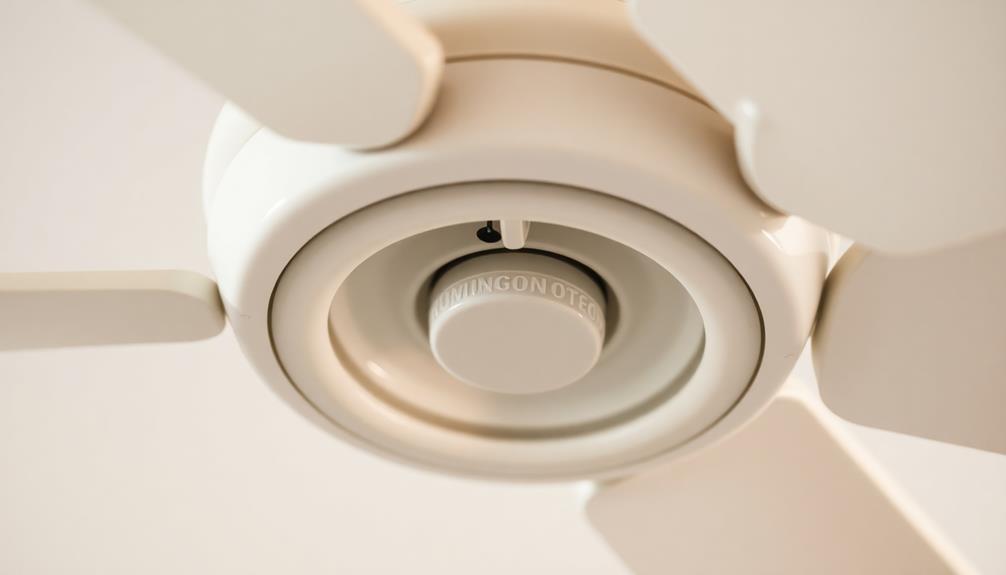
Excessive vibration from the mounting bracket can lead to a noticeable humming noise in your ceiling fan. To address this issue, you should inspect the bracket for any stability problems. Age-related wear can contribute to increased vibrations. Here's a quick checklist to help you troubleshoot:
| Action | Description |
|---|---|
| Inspect Bracket | Check for wear or damage |
| Tighten Screws | Confirm all screws are secure |
| Check Alignment | Verify the fan is properly aligned |
| Replace Mounting | Consider a new bracket if necessary |
| Regular Checks | Schedule routine inspections |
Importance of Regular Maintenance
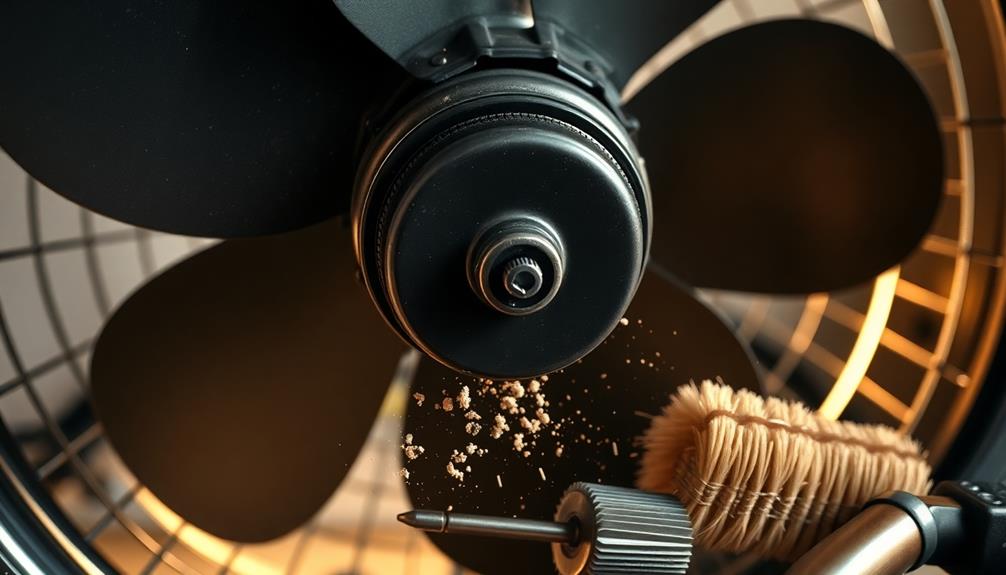
Regular maintenance is essential for keeping your ceiling fan running smoothly and quietly. By committing to routine care, you can enhance performance and extend the fan's lifespan.
Here are some key maintenance tasks you shouldn't overlook:
- Clean fan blades regularly to improve airflow and reduce noise.
- Tighten screws and bolts to eliminate vibrations that cause humming.
- Inspect wiring for any damage or loose connections to prevent electrical issues.
- Lubricate motor bearings to minimize friction and enhance quiet operation.
- Check blade alignment to guarantee balance and reduce wobbling sounds.
Taking these steps can help you enjoy a peaceful environment and guarantee your ceiling fan operates efficiently for years to come.
Effective Troubleshooting Techniques
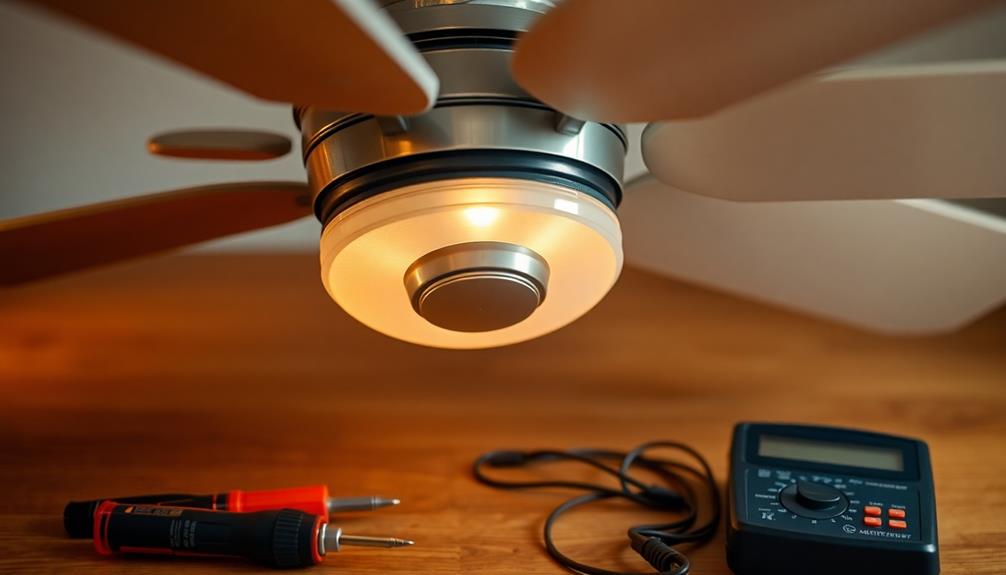
To maintain a quiet and efficient ceiling fan, knowing how to troubleshoot common issues is key. Start by tightening all screws and bolts to eliminate vibrations. If there’s still a persistent noise or imbalance, check the blades to ensure they aren’t warped or misaligned. Additionally, troubleshoot a **ceiling fan high speed problem** by inspecting the capacitor, which often affects the fan’s ability to run properly at maximum speed. If these steps don’t resolve the issue, it may be necessary to consult the manufacturer or a professional electrician for further assistance. Additionally, a **ceiling fan running too fast** can indicate a malfunctioning speed switch or a faulty internal wiring issue. To address this, it’s crucial to carefully inspect the speed controller and wiring connections to ensure everything is functioning as intended. If you’re unsure of how to handle electrical components, it’s best not to risk further damage and instead contact a professional electrician for a thorough diagnosis.
Next, check the blade alignment; adjust them if they're loose to guarantee balance. Inspect the wiring for any damage or loose connections, as these can lead to electrical noise.
Lubricate the motor bearings to reduce friction and humming sounds. Regularly clean dust and debris from the fan blades to enhance performance.
If you notice persistent humming, consider investigating the motor and mounting bracket for any signs of wear.
Design and Quality Factors

Understanding design and quality factors is essential for choosing a ceiling fan that operates quietly and efficiently. You should consider several aspects to guarantee your fan minimizes noise while delivering peak airflow.
- Blade Shape and Pitch: Steeper pitches can increase noise; choose wisely.
- Material Quality: Opt for wood or composite materials for better noise control.
- Motor Quality: High-quality motors reduce vibrations and humming.
- Aerodynamic Design: Look for blades designed to minimize turbulence.
- Installation Quality: Proper installation prevents excessive vibrations and noise.
External Influences on Noise
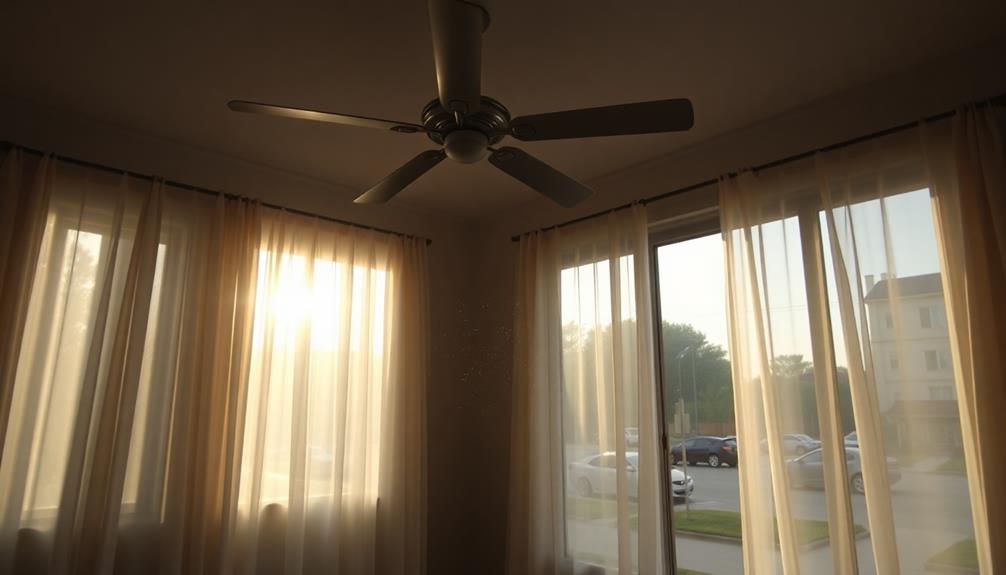
Sometimes, external factors can greatly influence the noise levels of your ceiling fan. For instance, nearby electronics can create electromagnetic interference, leading to unwanted sounds. You might notice a difference simply by moving devices away from the fan.
Additionally, dirty or dusty blades can disrupt airflow, causing increased noise. Regularly clean your fan blades with a microfiber cloth or a vacuum attachment to maintain their efficiency.
Environmental conditions, such as strong drafts or vibrations from other appliances, can also play a role. Pay attention to these factors, as addressing them can greatly reduce humming sounds and enhance your fan's performance, creating a more peaceful atmosphere in your living space.
Frequently Asked Questions
How Can I Tell if My Fan Is Humming Due to a Design Flaw?
To determine if your fan's humming stems from a design flaw, check for uneven blade alignment and stability. If the noise persists despite adjustments and maintenance, it might indicate inherent design issues requiring replacement or professional assessment.
Are Certain Fan Brands More Prone to Humming Noises Than Others?
Just like a choir, some fan brands harmonize quietly while others clash. You've likely noticed certain brands hum more often due to design or motor quality, so research and choose wisely to minimize noise.
What Are the Signs That a Ceiling Fan Needs Replacement?
If your ceiling fan wobbles excessively, makes unusual noises, or doesn't circulate air effectively, it's time for a replacement. Additionally, frequent repairs and an outdated design can signal that you need a new fan.
Can Weather Conditions Affect a Ceiling Fan's Noise Levels?
Yes, weather conditions can affect a ceiling fan's noise levels. Humidity and temperature changes might cause materials to expand or contract, leading to vibrations or loosened screws. Regular maintenance helps address these issues and maintain quiet operation.
Is It Safe to Operate a Humming Ceiling Fan Continuously?
It's generally not safe to operate a humming ceiling fan continuously. The noise often indicates underlying issues, like motor problems or loose parts, which could lead to further damage or even safety hazards if ignored.
Conclusion
In wrapping up, tackling that pesky humming noise from your ceiling fan doesn't have to feel like a challenging task. By keeping an eye on loose screws, unbalanced blades, and electrical issues, you can nip problems in the bud. Regular maintenance is key, and investing in quality fans can make all the difference. So, don't let that hum drive you up the wall—take action and restore peace to your space!


